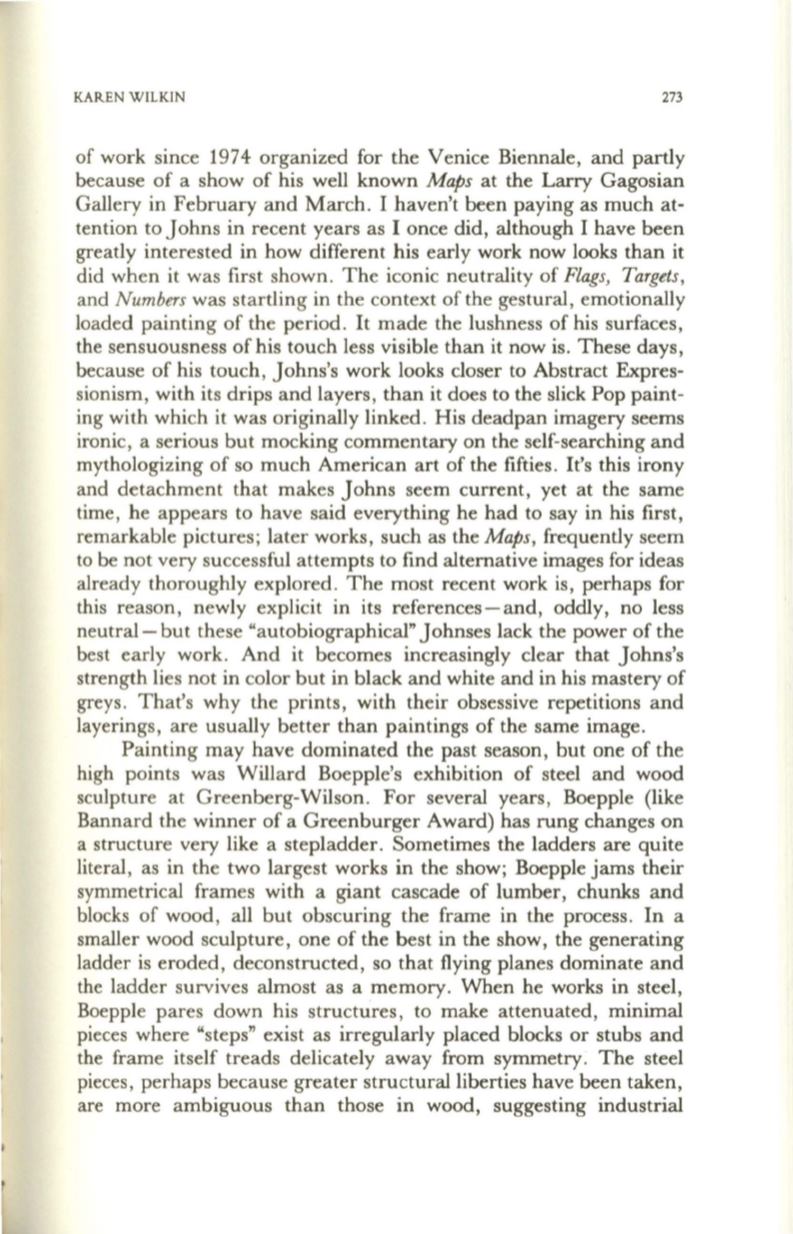
KAREN WILKIN
273
of work since 1974 organized for the Venice Biennale, and partly
because of a show of his well known
Maps
at the
Larry
Gagosian
Gallery in February and March . I haven't been paying as much at–
tention to Johns in recent years as I once did, although I have been
greatly interested in how different his early work now looks than it
did when it was first shown . The iconic neutrality of
Flags, Targets,
and
Numbers
was startling in the context of the gestural, emotionally
loaded painting of the period . It made the lushness of his surfaces,
the sensuousness of his touch less visible than it now is. These days,
because of his touch, Johns's work looks closer to Abstract Expres–
sionism, with its drips and layers, than it does to the slick Pop paint–
ing with which it was originally linked. His deadpan imagery seems
ironic, a serious but mocking commentary on the self-searching and
mythologizing of so much American art of the fifties. It's this irony
and detachment that makes Johns seem current, yet at the same
time, he appears to have said everything he had to say in his first,
remarkable pictures; later works, such as the
Maps,
frequently seem
to be not very successful attempts to find alternative images for ideas
already thoroughly explored . The most recent work is, perhaps for
this reason, newly explicit in its references-and, oddly, no less
neutral- but these "autobiographical" J ohnses lack the power of the
best early work. And it becomes increasingly clear that Johns's
strength lies not in color but in black and white and in his mastery of
greys. That's why the prints, with their obsessive repetitions and
layerings, are usually better than paintings of the same image.
Painting may have dominated the past season, but one of the
high points was Willard Boepple's exhibition of steel and wood
sculpture at Greenberg-Wilson. For several years, Boepple (like
Bannard the winner of a Greenburger Award) has rung changes on
a structure very like a stepladder. Sometimes the ladders are quite
literal, as in the two largest works in the show; Boepple jams their
symmetrical frames with a giant cascade of lumber, chunks and
blocks of wood, all but obscuring the frame in the process. In a
smaller wood sculpture, one of the best in the show, the generating
ladder is eroded, deconstructed, so that flying planes dominate and
the ladder survives almost as a memory. When he works in steel,
Boepple pares down his structures, to make attenuated, minimal
pieces where "steps" exist as irregularly placed blocks or stubs and
the frame itself treads delicately away from symmetry. The steel
pieces, perhaps because greater structural liberties have been taken,
are more ambiguous than those in wood, suggesting industrial


